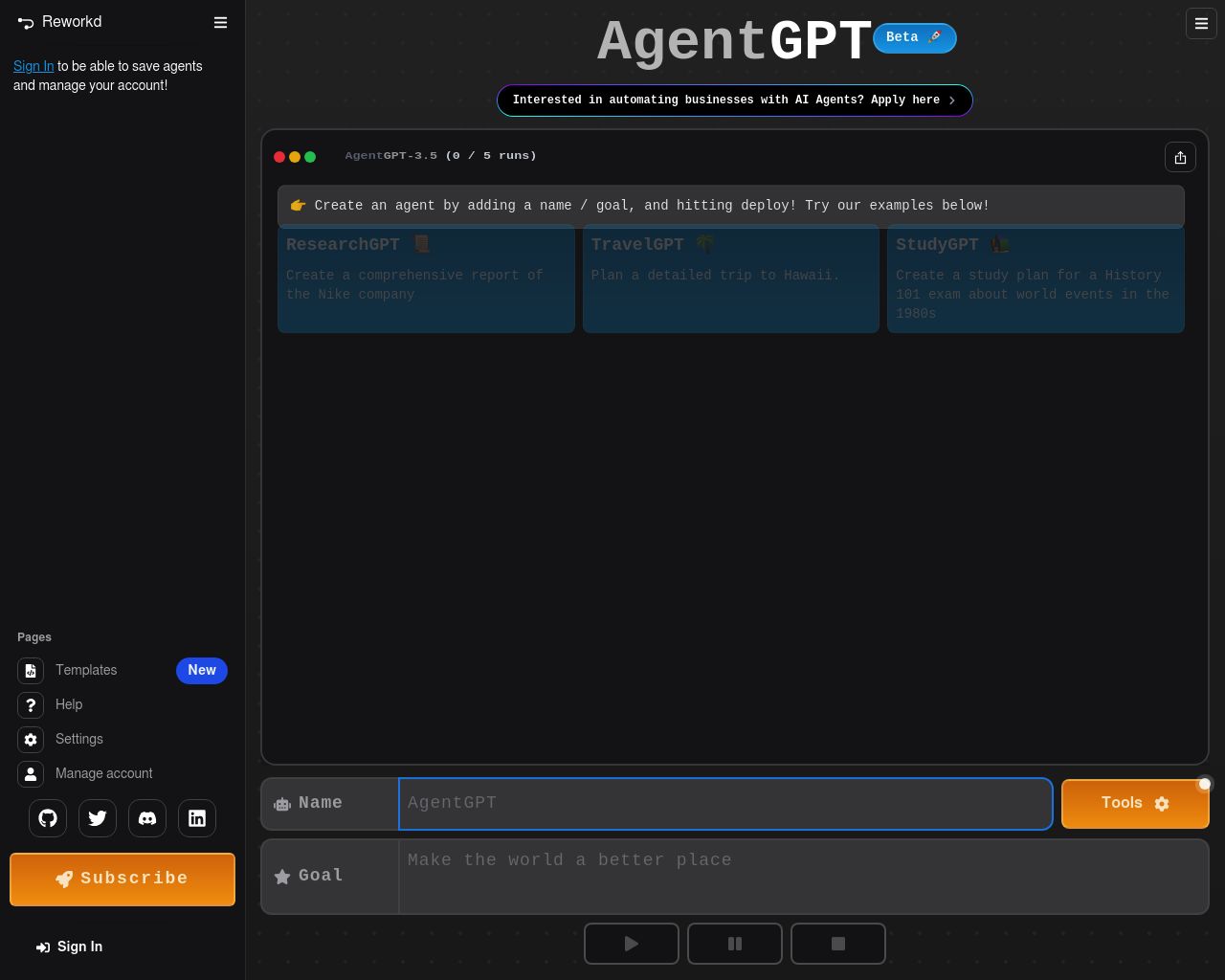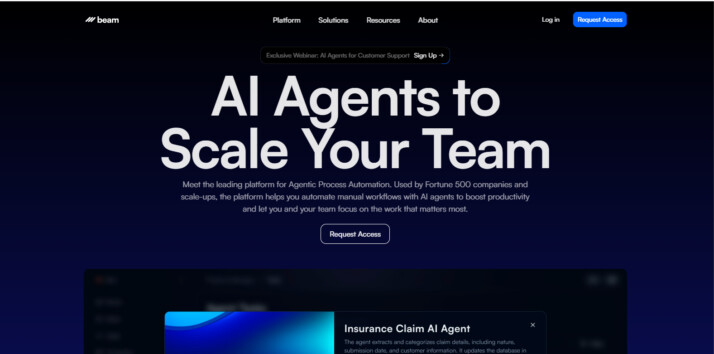AgentGPT vs. Beam AI: Comparing AI Automation Platforms
AI platforms AgentGPT vs. Beam AI offer distinct approaches to task automation, but both fall short in key areas that modern businesses require. This comparison examines their core functionalities, strengths, and limitations to help you make an informed decision. We’ll explore how these platforms stack up against SmythOS, a comprehensive AI development environment that addresses critical gaps in customization, security, and scalability. Whether you’re a developer seeking powerful APIs, a business leader focused on enterprise-grade solutions, or a non-technical user looking for accessible AI tools, this analysis will guide you through the landscape of AI automation platforms and highlight the superior capabilities offered by SmythOS.
AgentGPT Overview
AgentGPT empowers users to create and deploy autonomous AI agents directly in a web environment. Unlike conversational AI, these agents excel at tackling broad, goal-oriented tasks. The platform’s web-based interface distinguishes it from locally-operated alternatives, offering a more accessible approach to AI agent development.


AgentGPT boasts a robust feature set, including user authentication, agent run saving and sharing, dynamic language translations, and AI model customization. The platform’s web browsing capabilities and Stripe integration for premium services enhance its versatility. A standout feature is the use of vector databases for memory management, allowing AI agents to retain execution history and access long-term memory.
AgentGPT boasts a robust feature set, including user authentication, agent run saving and sharing, dynamic language translations, and AI model customization.
Developers benefit from AgentGPT’s docker-compose setup, which enables local runs without an API key. The platform’s cloud offering scales efficiently, integrating seamlessly with tools like LangChain. This combination of local development options and cloud scalability makes AgentGPT suitable for projects of various sizes.
While AgentGPT offers impressive capabilities, it lacks some advanced features found in other platforms. The absence of a visual builder or no-code editor may present a steeper learning curve for non-technical users. Additionally, the platform doesn’t explicitly mention features for explainability, debugging, or multi-agent collaboration, which could limit its applications in certain complex scenarios.
Despite these limitations, AgentGPT’s commitment to open-source development and its focus on autonomous, goal-oriented agents position it as a valuable tool for developers and businesses looking to harness AI for task automation and decision support. The platform’s ongoing evolution, driven by community contributions, suggests a promising trajectory for future enhancements and expanded capabilities.
Beam AI Overview
Beam AI develops generative AI agents to automate repetitive tasks for organizations. Their Agentic Process Automations (APAs) perform functions like data extraction, customer inquiry management, and order processing more efficiently than humans. These agents continuously learn and adapt, improving precision over time.
Beam AI’s platform focuses on back-office automation, customer service, compliance, and order processing. Their AI-native solutions emphasize sustainability and speed, aiming to minimize steps and enhance efficiency. The company’s international team works towards a future led by artificial general intelligence (AGI).


Beam AI develops generative AI agents to automate repetitive tasks for organizations. Their Agentic Process Automations (APAs) perform functions… more efficiently than humans.
Beam AI equips its agents with advanced conversational interfaces for seamless interaction and task management. The agents integrate with existing systems to plan and execute workflows automatically. While Beam AI offers powerful automation capabilities, it lacks some features found in more comprehensive platforms. The solution doesn’t include a visual builder or no-code editor, which may limit accessibility for non-technical users. Additionally, there’s no mention of multimodal capabilities, debug tools, or human-AI collaboration features.
For organizations primarily focused on task automation and workflow optimization, Beam AI provides a solid foundation. However, those seeking a more versatile platform with extensive customization options and broader AI capabilities may need to explore alternatives. Beam AI’s strengths in back-office automation and customer service make it well-suited for businesses looking to streamline operations in those specific areas.
Feature Comparison
AgentGPT and Beam AI offer distinct approaches to AI agent development, each with its own strengths and limitations. AgentGPT provides a web-based platform for creating autonomous AI agents, emphasizing accessibility and goal-oriented task completion. Its vector database integration enables long-term memory capabilities, enhancing agent performance over time. However, AgentGPT lacks a visual builder and no-code editor, potentially limiting its appeal to non-technical users.
Beam AI focuses on automating repetitive tasks through its Agentic Process Automations (APAs). These agents excel in areas like data extraction, customer inquiry management, and order processing. Beam AI’s platform emphasizes continuous learning and adaptation, improving precision with use. Unlike AgentGPT, Beam AI does not offer a visual builder or extensive customization options, which may restrict its flexibility for some users. Additionally, Beam AI’s lack of explicit debug tools and multi-agent collaboration features could pose challenges for complex implementations.
Both platforms have gaps in core components and security features. Neither offers robust explainability tools, debug modes, or advanced human-AI interaction capabilities. AgentGPT and Beam AI also lack comprehensive security features like data encryption and IP control, which could be concerning for enterprises handling sensitive information. These limitations highlight areas where both platforms could improve to meet the evolving needs of AI development and deployment.
Feature Comparison Table
| AgentGPT | Beam AI | SmythOS | |
|---|---|---|---|
| CORE FEATURES | |||
| Visual Builder | ❌ | ❌ | ✅ |
| No-Code Options | ❌ | ❌ | ✅ |
| Explainability & Transparency | ❌ | ✅ | ✅ |
| Debug Tools | ✅ | ❌ | ✅ |
| Multimodal | ✅ | ❌ | ✅ |
| Human-AI Interaction | ❌ | ✅ | ✅ |
| SECURITY | |||
| Constrained Alignment | ❌ | ✅ | ✅ |
| IP Control | ❌ | ✅ | ✅ |
| COMPONENTS | |||
| Foundation AIs | ❌ | ✅ | ✅ |
| Data Lakes | ❌ | ❌ | ✅ |
| DEPLOYMENT OPTIONS (EMBODIMENTS) | |||
| Staging Domains | ❌ | ✅ | ✅ |
| Production Domains | ❌ | ✅ | ✅ |
| Deploy as Scheduled Agent | ❌ | ✅ | ✅ |
| DATA LAKE SUPPORT | |||
| Hosted Vector Database | ✅ | ❌ | ✅ |
| Sitemap Crawler | ❌ | ❌ | ✅ |
| YouTube Transcript Crawler | ❌ | ❌ | ✅ |
| URL Crawler | ✅ | ❌ | ✅ |
Best Alternative to AgentGPT and Beam AI
SmythOS stands out as the superior alternative to AgentGPT and Beam AI, offering a comprehensive platform for AI agent development and deployment. Our drag-and-drop interface revolutionizes the creation process, making it accessible to users of all technical backgrounds. Unlike AgentGPT and Beam AI, we provide a true no-code solution, empowering non-developers to build sophisticated AI agents without writing a single line of code.
SmythOS stands out as the superior alternative to AgentGPT and Beam AI, offering a comprehensive platform for AI agent development and deployment.
Our platform excels in versatility, supporting a wide range of use cases that AgentGPT and Beam AI struggle to match. From customer service chatbots to complex data analysis tools, SmythOS adapts to diverse business needs with unparalleled ease. We offer seamless integration with popular APIs and services, allowing users to connect their agents to existing workflows effortlessly.
SmythOS surpasses both AgentGPT and Beam AI in terms of scalability and performance. Our robust infrastructure ensures that agents can handle high volumes of requests without compromising speed or accuracy. This scalability is crucial for businesses looking to grow their AI capabilities alongside their operations. Additionally, our platform provides advanced debugging tools and performance analytics, features notably absent in AgentGPT and limited in Beam AI.
SmythOS surpasses both AgentGPT and Beam AI in terms of scalability and performance.
Security and compliance are top priorities for SmythOS. We implement stringent data encryption and access controls, addressing the security gaps present in AgentGPT and Beam AI. Our platform also offers detailed audit logs and monitoring capabilities, ensuring transparency and accountability in AI operations. These features are particularly valuable for enterprises dealing with sensitive information or operating in regulated industries.
By choosing SmythOS, users gain access to a feature-rich, user-friendly platform that outperforms AgentGPT and Beam AI in key areas. Our commitment to innovation, ease of use, and comprehensive support makes SmythOS the ideal choice for businesses and individuals looking to harness the full potential of AI agents in their operations.
Conclusion
AgentGPT and Beam AI offer unique approaches to AI-driven task automation, each with distinct strengths. AgentGPT’s web-based platform enables the creation of autonomous AI agents for broad, goal-oriented tasks. Its vector database integration and scalable cloud offering make it suitable for various project sizes. Beam AI focuses on automating repetitive tasks through Agentic Process Automations, excelling in areas like data extraction and customer inquiry management.
While both platforms provide valuable automation capabilities, they lack some advanced features. Neither offers a visual builder or comprehensive security measures, which may limit their appeal to certain users. For organizations seeking a more robust and versatile solution, SmythOS emerges as the superior choice.
SmythOS stands out with its intuitive drag-and-drop interface, extensive integration ecosystem, and versatile deployment options. Our platform supports multi-agent orchestration, enabling complex task collaboration. With pre-built API integrations and templates, SmythOS significantly reduces setup time, allowing users to focus on innovation. The ability to deploy agents across various platforms, including major cloud services and as ChatGPT plugins, ensures seamless integration into existing systems.
For businesses and individuals looking to harness the full potential of AI, SmythOS offers unparalleled flexibility and power. Our comprehensive solution addresses the limitations found in AgentGPT and Beam AI, providing a secure, scalable, and user-friendly environment for AI agent development. Explore our diverse range of AI-powered agent templates to jumpstart your journey into advanced AI automation. Create a free SmythOS account today and experience the future of AI-driven productivity.
Last updated:
Disclaimer: The information presented in this article is for general informational purposes only and is provided as is. While we strive to keep the content up-to-date and accurate, we make no representations or warranties of any kind, express or implied, about the completeness, accuracy, reliability, suitability, or availability of the information contained in this article.
Any reliance you place on such information is strictly at your own risk. We reserve the right to make additions, deletions, or modifications to the contents of this article at any time without prior notice.
In no event will we be liable for any loss or damage including without limitation, indirect or consequential loss or damage, or any loss or damage whatsoever arising from loss of data, profits, or any other loss not specified herein arising out of, or in connection with, the use of this article.
Despite our best efforts, this article may contain oversights, errors, or omissions. If you notice any inaccuracies or have concerns about the content, please report them through our content feedback form. Your input helps us maintain the quality and reliability of our information.
